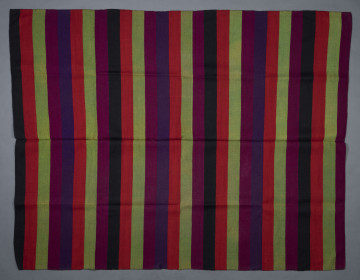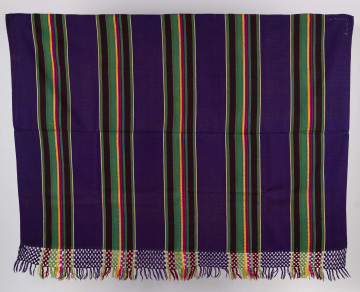
Striped rug
1920
National Museum in Lublin
Part of the collection: Folk craft of the Lublin Region (19th/20th c.)
The rectangular linen towel was made in 1915 in the village of Rusły in the Włodawa region, on a weaving workshop with four threads with a shorter reed, using the picking technique. It was used to decorate, among others, a home altar. The decorative motif placed on both edges is called ‘perebora’ and is characteristic of decorating textiles in the north-eastern Lublin region. This form of weaving is known in northern and eastern Europe and was adopted in the vicinity of Włodawa, Parczew and, parts of the Biała regions from the Poleshuks. At first, it was used by Ruthenians and later by Polish people to decorate elements of Włodawa and Bug River festive costumes and towels.
Towels were commonly made until the beginning of the 20th century; in the post-war years the skill of their weaving was maintained by only a few weavers in the Włodawa region. This should be explained by the disappearance of old, labour-intensive festive costumes. The presented motif is a typical layout for Lublin ‘pereboras’, where straight stripes and geometric patterns prevailed. It was due to the weaving technique, which to some extent imposed the character of the ornament; it was woven on white linen cloth and the pattern was made mainly with cotton thread in two or three colours. Red was dominant in the oldest preserved towels; less used threads were navy blue or rarely orange or yellow. In the presented ornamental motif, asymmetrical red stripes with narrow orange and navy-blue stripes with white background elements and again red stripes with navy blue dominate. The widest pattern is woven with concentric rhombuses, through which passes a dark blue dotted line. Between the rhomboids are small geometric hearts. Further, a similar striped pattern is repeated, except that the rhombus motif is introduced after the red stripes have been repeated three times. It is also repeated three times. The width of the whole embroidery is 16 cm. The pattern thus created looked identical both on the right and on the left, and sometimes it was difficult to distinguish between them.
Author / creator
Dimensions
cały obiekt: height: 123 cm, width: 34,5 cm
Object type
towel
Technique
weaving
Material
flax
Creation time / dating
Creation / finding place
Owner
The National Museum in Lublin
Identification number
Location / status

1920
National Museum in Lublin

1890 — 1910
National Museum in Lublin

1925
National Museum in Lublin
DISCOVER this TOPIC
Castle Museum in Łańcut
DISCOVER this PATH
Educational path